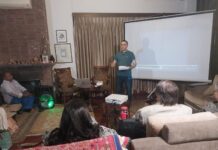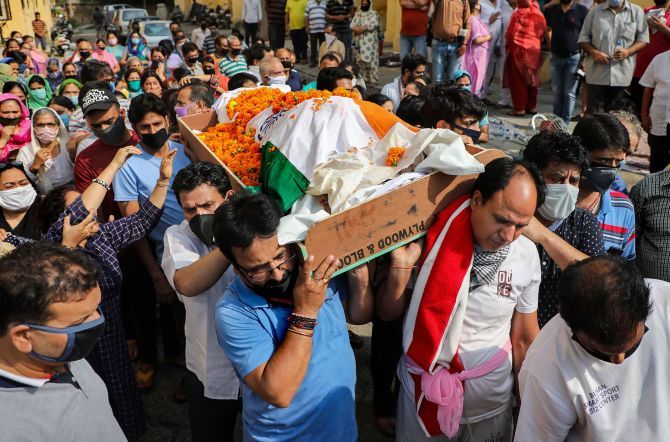A Kashmiri Pandit, Puran Krishan, was shot dead in south Kashmir’s Shopian district on November 6, 2022. he is the third person from the Pundit community to be killed in Kashmir (Kashmiri Pandit shot dead in Shopian, Hindustan Times Oct 16, 2022.The community believes that the unabated third killing in succession exposes the BJP government’s myth of “normalcy” in the disputed state. Civilian killings in Kashmir contradict the narrative of normalcy. Residents blame it on the BJP’s “militaristic policy” to change Kashmir demography by issuing domicile certificates to non-Kashmiri residents.
The Frontline questioned: Are the attacks on Pandits a fallout of New Delhi’s iron-fisted bureaucratic control of Jammu and Kashmir, marked by the arbitrary use of anti-terror laws against people with dissenting viewpoints, including journalists, and the summary incarceration of Hurriyat and religious leaders? Are they a backlash to the government’s perceived plan to reorient the region’s demographics? Can economic incentives and doles aimed at boosting Jammu and Kashmir’s ramshackle economy be a panacea for a layered political conflict? What are the perceptions, anxieties, and political reflections of Kashmir’s Muslim majority? (The Frontline, Nov 03, 2022).
Perhaps irked by the volatile situation in the occupied Kashmir, India’s Union Finance Minister Nirmala Sitharaman (November 5, 2022) hinted at the possibility of the Centre considering restoring state status to the disputed Jammu and Kashmir. She dropped the hint while talking about the distribution of funds to the states by the Centre as per the recommendations of the 14th Finance Commission. Sitharaman was delivering a lecture on “Cooperative Federalism: The Path Towards Atma Nirbhar Bharat ” organised here by Bharatiya Vichara Kendram in memory of Sangh idealogue P Parameshwaran (Will J&K’s statehood be restored? Here’s what FM Nirmala Sitharaman said, India Today, Nov 6, 2022).
NGOs’ efforts to get dialogue kick-started
Several NGOs including Institute of International Relations (KIIR), Islamabad/Muzaffarabad advocate dialogue as the only possible way out of the Kashmir tangle. They have been highlighting the miserable life in the occupied Kashmir. The Institute has been contributing to developing durable relationship with individuals, interest groups and institutions in South Asia and around the world working towards conflict resolution and human rights.
In its efforts for global peace and resolution of Kashmir conflict KIIR has engaged policy makers and policy implementers: members of parliament, political activists, lawyers, journalists, academics and social activists.
Plebiscite and other solutions
Inability to hold a plebiscite led to academic discussion on alternative solutions. Pakistan view is India negated the cardinal principle in inter-state relations, that is, pacta sunt servanda `treaties are to be observed’ and are binding upon signatories. Till 1954, India kept saying that it was committing to holding a plebiscite. Now it says the United Nations are mediatory in nature. And, as such, not of a binding nature. India pleads the United Nations’ resolutions have become antiquated: clasula rebus sic stantibus (things as they stand, or fundamental change of circumstances. In the case of a ‘fundamental change of circumstances’, that existed when a treaty was concluded, a party to that treaty may invoke this fact as a ground for termination or suspending operation of a treaty.
India’s foreign secretary JN Dixit’s view
As quoted in Victoria Schofield’s book Kashmir in the Crossfire, JN Dixit says ‘it is no use splitting legal hair. Everybody who has a sense of history knows that legality only has relevance up to the threshold of transcending political realities. And especially in inter-state relations… so to quibble about points of law and hope that by proving a legal point you can reverse the process of history is living in a somewhat contrived utopia. It won’t work.’
Kashmir is a nuclear tinderbox. The two neighbours must bury the hatchet and talk eyeball-to-eyeball about it.
A plethora of solutions
Academic solutions abound: (a) Freezing the Territorial Status Quo. This solution offers the Kashmiris south of the LoC both Kashmiri ID cards and Indian passports. Likewise, it offers those on the north of the LoC, Kashmiri ID cards and Pakistani passports (Marc Weller. and Staffan Wolff (eds.), Autonomy, Self-Governance and Conflict Resolution, New York, Routledge Taylor and Francis Group, 2005, pp. 41,42). (b) Andorra Model: Andorra was a unique co-principality- (without any arbitrator), ruled by the French chief of state and the Spanish bishop of Urgel for 715 years. Through a constitution, enacted in 1993, the government was transformed into a parliamentary democracy with both French and Spanish heads of states jointly wielding executive powers (as well as defence) as co-principis. When this solution was first proposed by Hurriyat Conference (in 1974), President Musharraf supported it.
However, all sections of the Indian media termed this solution ‘Pandora’s box’. (c) Sweden-Finland Aland-Island Model: Swedish nationals in Finland controlled the Island. They wanted to unite it with Sweden. But, Finland did not allow them to do so. With League of Nations appointed as an arbitrator in 1921, the island was given the status of an autonomous territory. Finland retains nominal sovereignty over the island with obligation to ensure linguistic rights (Swedish language) as well as culture and heritage of Aland residents. The island enjoys a neutral and demilitarised status with its own flag, postage stamps and police force. On December 31, 1994, Aland joined the European Union voluntarily. Aland is a self-governing entity, created without use of force, catering for conflicting interests of rival communities. (d) Italy-Austria South Tyrol Model: South Tyrol was part of Austria.
It was inhabited by three linguistic groups (70% Germans, 26% Italians, and 4% Ladin). It was annexed by Italy in 1919. The German majority rebelled against Italianisation. An agreement between Austria and Italy provided an autonomy framework, vouchsafed by Paris Peace Agreement, 1946 (also known as Gruber Degasperi Agreement). Under the South Tyrol Package of 1969, Austria exercised a mandatory protective function vis-à-vis Italy for the Austrian and Ladin minorities in South Tyrol.
The package was meant to pave the way for peaceful co-existence of German- and Ladin-speaking communities of South Tyrol, particularly in the multi-ethnic province of Bolzano. The package collapsed and gave way to a settlement in 1992 with the United Nations as the arbitrator. The revised package still recognizes Italian sovereignty but allows greater autonomy of legislation and administration, recognition of cultural diversity, minority vote on issues of fundamental importance, and proportional ethnic representation. (e) National Conference Autonomy Formula (2001): The formula envisages return to 1953 position, abrogation of all central laws imposed on the state, and an informal co-federal relationship between the parts of Kashmir. (f) Chenab Formula: According to this formula the River Chenab will form the separation line between free (Azad) and occupied parts of Kashmir. Some writers have discussed the Indus-basin-based formula, akin to it. (g) Kashmir-Study-Group Formula: It envisages division of the state into two self-governing entities, enjoying free access to one another.
The entities would have their own democratic constitutions, citizenship, flag, and legislature (sans defence matters jurisdiction). Defence would be the joint responsibility of India and Pakistan. (h) Other solutions like Sami parliamentary model, Italy-Yugoslavia Trieste model, Basque leader Jose Ibarretxe ideas, and Caledonia island (discovered in 1774), sovereignty sharing Noumea agreement (1999).
UN rep Dixit’s Plan
Dixon talked with all stakeholders and came up with a planLa) Ladakh should be awarded to India. (b) Azad Kashmir (including Gilgit & Baltistan) should remain with Pakistan. (c) Whole Kashmir valley should have a plebiscite with no option to independence (and it might have gone to Pakistan). (d) Jammu should be divided on religious basis. The river Chenab should be the dividing line. Northern Jammu (Muslims dominated) should go to Pakistan and Hindu majority parts of Jammu to remain with India.
In short, Muslim areas should have gone with Pakistan and Hindu-Buddhist majority areas should have remained with India. India rejected the Dixon plan. India never accepted the plan at heart.
AG Noorani says ‘The Dixon Plan (1950) is even today nostalgically cherished by the people of Kashmir as a viable solution of the Kashmir issue. Sir Owen Dixon, an Australian judge, in his capacity as representative for India and Pakistan, proposed this plan pursuant to the Security Council’s Resolution of March 14, 1950’.
The Kashmir Dispute 1947-2012 A.G. NOORANI, The Dixon Plan, The Frontline , October 25, 2002).
Jagat S Mehta’s formula
Parvez Musharraf’s four-point formula appears to be a modification of Indian foreign Secretary, Jagat S. Mehta’s proposals. Mehta understood India’s abhorrence to the word ‘plebiscite’. So he presented some proposals to serve as requirements for evolving a solution after a period of ten years. His proposals are contained in his article “Resolving Kashmir in the International Context of the 1990s”.
Some points of his quasi-solution are: (a) Pacification of the valley until a political solution is reached. (b) Conversion of the Loc into “a soft border permitting free movement and facilitating free exchanges…” (c) Immediate demilitarization of the Loc to a depth of five to ten miles with agreed methods of verifying compliance. (d) Final settlement of the dispute between India and Pakistan can be suspended (kept in a “cold freeze”) for an agreed period. Voracious readers may refer for detail to Robert G Wirsing, India, Pakistan and the Kashmir Dispute (1994, St Martin’s Press, New York pp. 225-228).
Concluding thought
Kashmir is a nuclear tinderbox. The two neighbours must bury the hatchet and talk eyeball-to-eyeball about it.























